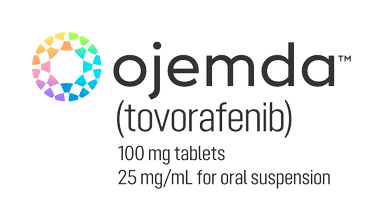Breslyn, lives with pLGG, and Noelle, her sister
Safety and side effects
OJEMDA was generally well tolerated in the clinical study
When the results of the FIREFLY-1 study were reviewed,
74%
of children were still taking OJEMDA
(102 out of 137)
93%
of children did not stop taking OJEMDA due to side effects
(128 out of 137)
The main side effects that caused 7% of children (9 out of 137) to stop taking OJEMDA were:
- Bleeding from the tumor (3 out of 137)
- Slowing of growth (2 out of 137)
If your child experiences any serious side effects during treatment with OJEMDA, your child’s doctor may decrease dosage, pause treatment, or stop treatment.
The FIREFLY-1 main phase will conclude by the end of 2024, after which patients will be followed for longer-term observation.
What are the possible side effects?
OJEMDA may cause serious side effects, including
Bleeding problems,
such as nose bleeds or bleeding from the tumor
Call your child’s doctor immediately if they have any symptoms, including:
- Headache, dizziness, or feeling weak
- Coughing up blood or blood clots
- Vomiting blood or vomit looks like coffee grounds
- Red or black stools that look like tar
Skin reactions, including sensitivity to sunlight (photosensitivity)
Call your child’s doctor if your child gets new or worsening skin reactions, including:
- Rash
- Bumps
- Acne
- Peeling, redness, or irritation
- Blisters
Liver problems
Your child’s doctor will do blood tests to check your child’s liver function before and during treatment with OJEMDA. Call your child’s doctor right away if your child gets any of the following symptoms:
- Yellowing of skin or eyes
- Dark or brown (tea-colored) urine
- Nausea or vomiting
- Loss of appetite
- Tiredness
- Bruising
- Bleeding
- Pain in the upper right stomach area
Slowing of growth (height)
- Your child’s growth will be checked routinely during treatment with OJEMDA
Other safety considerations
OJEMDA may cause fertility problems in males and females. Talk to your healthcare provider if this is a concern for you.
What are the most common side effects?
The 137 children in the clinical study mostly experienced mild to moderate side effects while taking OJEMDA. Talk to your child’s care team right away if they experience any side effects, and discuss ways to manage them.
Rash
Found in
77%
of children
Management tips
- Soothe with a warm bath; use unscented creams and gentle soaps
- Moisturize dry skin with lotions to help retain moisture
Hair color changes
Found in
76%
of children
Management tips
- Discuss with your child how they’d like to handle their hair if it lightens or turns white
- Consider whether your child would like to dye their hair
- Once the treatment is stopped, the child’s hair, eyebrows, and eyelashes may grow back in their natural color
Fatigue (tiredness)
Found in
55%
of children
Management tips
- Allow more time for naps and reduce activity to conserve your child’s energy
- Help your child drink lots of fluids and eat well
- Encourage exercising when possible
Viral infection
Found in
55%
of children
Management tip
- Call your child’s care team if they’re showing signs of a viral infection like a cold or flu, so your doctor can help choose the best treatment plan
Vomiting
Found in
50%
of children
Management tips
- Feed your child frequent small snacks (empty stomachs can make vomiting worse)
- Encourage your child to sip liquids slowly throughout the day
Headache
Found in
45%
of children
Management tips
- Use a cold washcloth and place it on your child’s forehead or the back of their neck
- Ask your child’s care team about taking over-the-counter headache medicine to reduce the pain
- Help your child rest in a darkened room
Fever
Found in
39%
of children
Management tips
- Contact your child’s care team right away if your child gets a fever
- Give your child plenty of liquids and place a cold cloth on their forehead
Dry skin
Found in
36%
of children
Management tips
- Soothe with a warm bath; use unscented creams and gentle soaps
- Moisturize dry skin with lotions to help retain moisture
Constipation
Found in
33%
of children
Management tips
- Give your child warm fluids often
- Feed your child high-fiber foods
Nausea
Found in
33%
of children
Management tips
- Feed your child frequent small snacks (empty stomachs can make nausea worse)
- Encourage your child to sip liquids slowly throughout the day
Acne
Found in
31%
of children
Management tips
- Soothe with a warm bath; use unscented creams and gentle soaps
- Moisturize dry skin with lotions to help retain moisture
Upper respiratory tract infection
Found in
31%
of children
Management tip
- Call your child’s care team if your child is showing signs of a viral infection, or an upper respiratory infection, like a cold or bronchitis. Your child’s doctor can help choose the best treatment plan
These are not all the possible side effects with OJEMDA. Talk to your child’s care team for medical advice about possible side effects.
You may report side effects to the FDA at 1‑800‑FDA‑1088.
You may also report side effects to Day One Biopharmaceuticals at 1‑855‑DAY1‑BIO (1‑855‑329‑1246).
“Side effects can happen with any medication. It is important to discuss any symptoms your child may experience while taking OJEMDA so that your doctor can advise on the appropriate course of action.”
—Dr Peter Manley, Vice President, Clinical Development, at Day One Biopharmaceuticals
